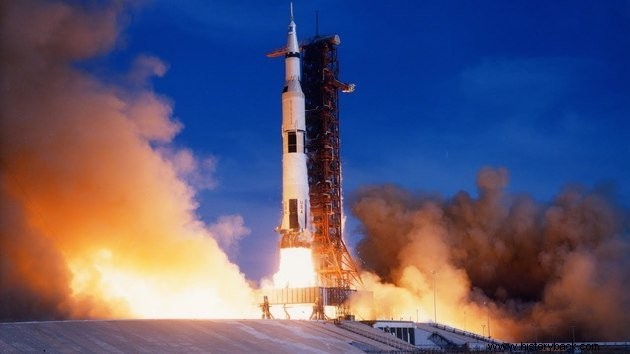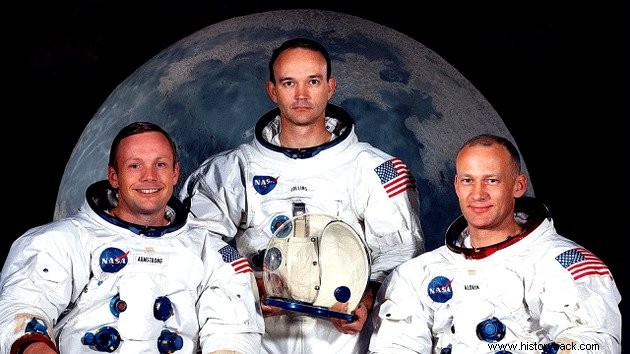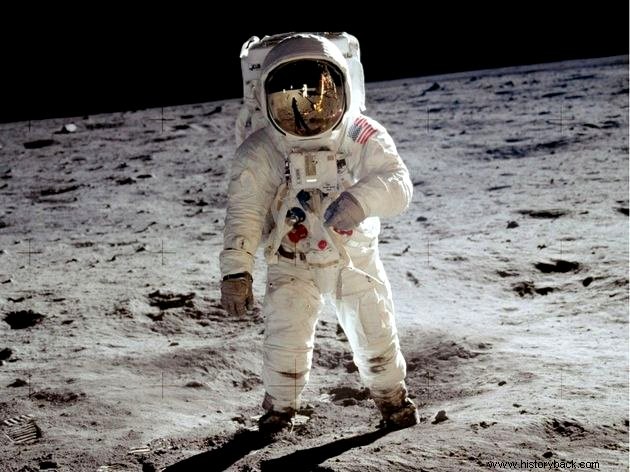The mission Apollo 11 made possible the descent to the Moon on July 20, 1969 and marked a great scientific and political achievement for the United States.
The crew consisted of Neil Armstrong and Edwin 'Buzz' Aldrian, the first men to set foot on the moon, and Michael Collins who remained in the command module.
Mission Journey to the Moon
The Apollo Program consisted of a series of experiments and orbital trips with the aim of getting man to step on the lunar soil. It is estimated that around 150,000 scientists, including engineers, designers and mathematicians, worked on the project.
The spacecraft was the culmination of a chain of experiments carried out ten years ago by the American Space Agency (NASA) since the early 1960s.

The American role in the Space Age began with Project Mercury (1958-1963). It would later be replaced by Project Gemini (1961-1966) which put the first American, John Glenn (1921-2016), into orbit on February 20, 1962.
In turn, the Apollo Project began in 1961 and its first mission did not go into space, as the chosen astronauts suffered a fatal accident while still in the testing phase.
From Apollo 2 to Apollo 10, American scientists learned and corrected the errors observed so that the trip was safe both on the way out and on the way back.
Thus, they chose to design a spacecraft divided into three modules and only one would be specially prepared to alunize.
The Apollo 11 mission spacecraft consisted of:
- Service Module :with propulsion, energy, oxygen and water.
- Command Module :a cabin for the three crew (this part returned to Earth).
- Lunar Module :called “Eagle” (Eagle), to land on the satellite.
To put this one in orbit, scientists created the most powerful rocket ever created:the Saturn V.
The Apollo 11 mission was a success and without major incidents on the outward journey. The astronauts stayed two hours and forty-five minutes on the Moon, planted the US flag and collected rocks and sand.
They also left a seismograph that sent information about the Moon's seismic activities for five weeks. Likewise, they put up a sign with the message signed by them and by President Richard Nixon:
It was only when it was time to return that there was a difficulty. Upon returning to the lunar module, Aldrin noticed that the part that would turn on the circuit breaker had fallen. After much guesswork, he turned on the device by tripping the circuit breaker with a felt-tip pen.
After returning to Earth, the astronauts spent 21 days in quarantine to make sure they hadn't brought any organisms that could endanger the planet.
Men on the Moon

The Apollo 11 crew consisted of three veteran space travel astronauts:
Neil Armstrong
Born August 5, 1930, Neil Armstrong was a space engineer and served as a fighter pilot during the Korean War (1950-1953). After the conflict, he would work as a test pilot for airlines.
He was one of nine chosen for Project Gemini and made his first orbital flight in 1966. Three years later, he was selected to be the commander of Apollo 11 for his cool-headedness and reserved character.
After returning from spaceflight, he would still participate in the investigation of accidents at NASA and would dedicate himself to teaching at the University of Cincinnati. He passed away in 2012 at the age of 82.
See also:Life of Neil Armstrong (the first man to walk on the moon)Michael Collins
He was born in 1930 into a family with a military tradition. He joined the United States Air Force and served as an American NATO pilot on a mission in Europe. He joined the space program in 1963 and made his first trip in 1966 when he "walked" through space.
Collins remained in the command module while Armstrong and Aldrin roamed the Moon. Even though he didn't make it to the moon, Collins' mission was very important, as his return home depended on him.
Upon his return, Collins was director of the US National Aerospace Museum, the Smithsonian Institution, and a professor at Harvard University.
Edwin 'Buzz' Aldrian
Born in 1930, Aldrian was considered the smartest of the three. He was a pilot in the US Air Force and joined the NASA program in October 1963 and was part of the last trip of the Gemini project, 1966.
Selected for Apollo 11, he developed a method that would allow him to fly the Eagle module without needing help when it was time to return.
Unlike his fellow travelers, Aldrian remains a space travel enthusiast and actively supports missions to the planet Mars.
See also:Man's Journey to the MoonSpace Race

The conquest of orbital space by the human being can only be understood in the context of the Cold War, when the United States and the USSR vied for world supremacy.
Each wanted to show the world the advantages of their economic system. For this, they resorted to sport, weapons and especially science, to prove the superiority of socialism or capitalism.
The Soviets took the lead in the space race by launching the first artificial satellite:Sputniki, on October 4, 1957. This unleashed panic among the Americans, as no one knew what the Soviets might be seeing from the sky.
A month later, they launched the first living being into space, the dog Laika, on November 3, 1957.
For their part, the Americans created NASA (National Aeronautics and Space Administration ), in 1958, in order to concentrate the efforts of scientists and astronauts to conquer Earth orbit.
However, what made the Americans really accelerate their space program, was the trip undertaken by the Soviet cosmonaut, Yuri Gagarin (1934-1968).
On April 12, 1961, Gagarin became the first man to go around the planet completely and spend 108 minutes in space.
A month later, US President John F. Kennedy (1917-1963) delivered a famous speech to the US Congress. Kennedy said that the United States should be the first to get astronauts safely to the moon and back.
Even with the assassination of the president in 1963, funding remained generous for NASA to accomplish this feat.
The Soviets would still send the first woman and civilian into Earth orbit, Valentina Tereshkova (1937), on June 16, 1963.
See also:Space RaceCuriosities
- In 1996 a TV movie was released about the Apollo 11 mission directed by Norberto Barba.
- The astronaut doll from the "Toy Story" series was named "Buzz" in honor of the astronaut.
- As the Cold War ended, the space program also no longer interested the American public. The last lunar mission took place in 1972 with Apollo 17.
- President Trump, in 2018, promised that Americans would once again be pioneers in space travel with a mission to the planet Mars.
Understand more about the Apollo mission with this video :
Space Race